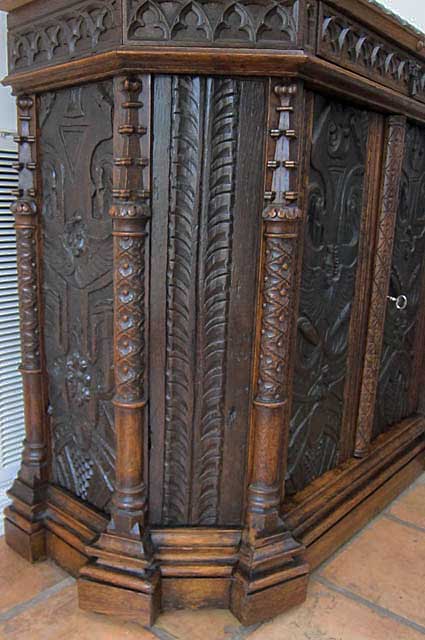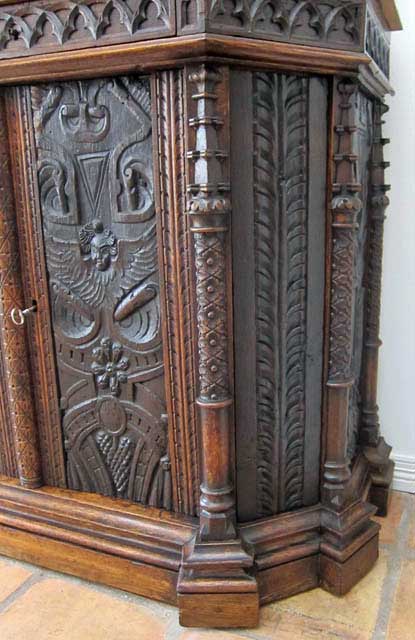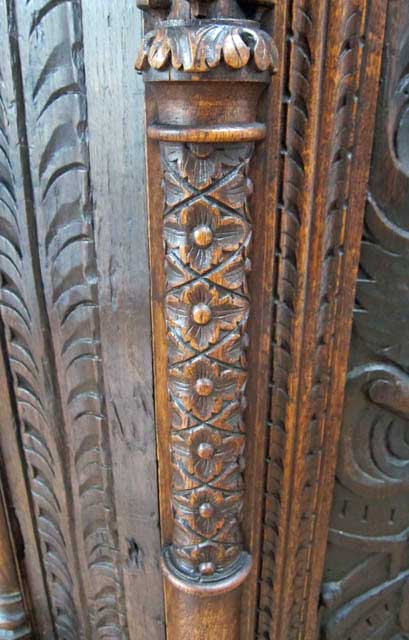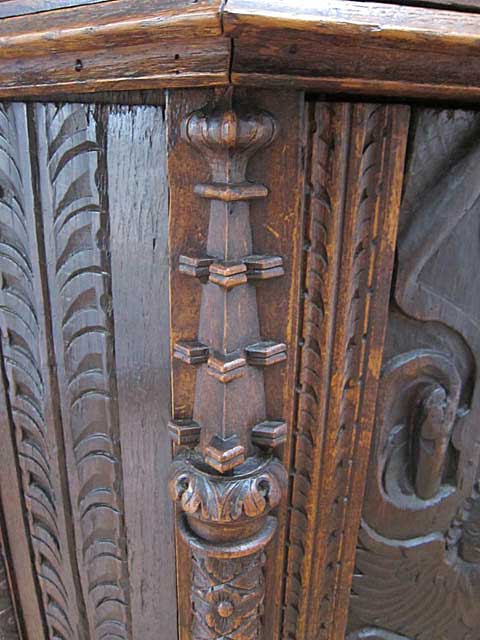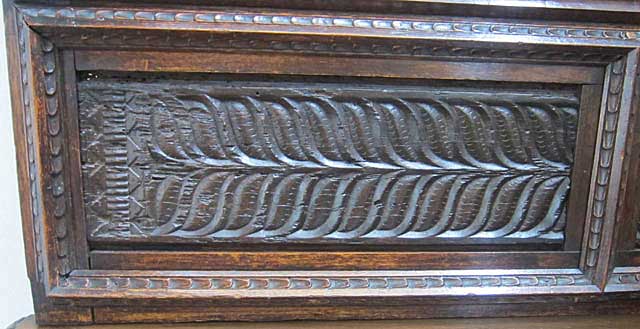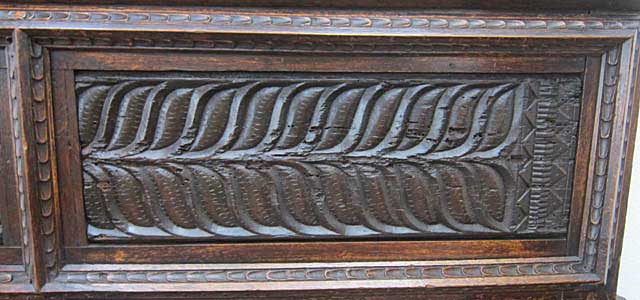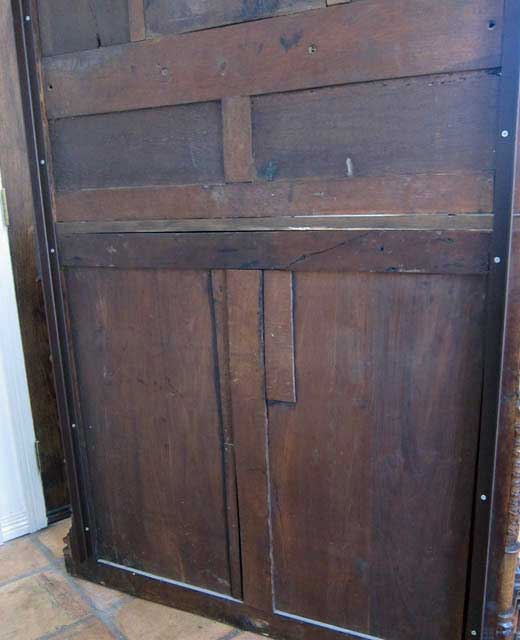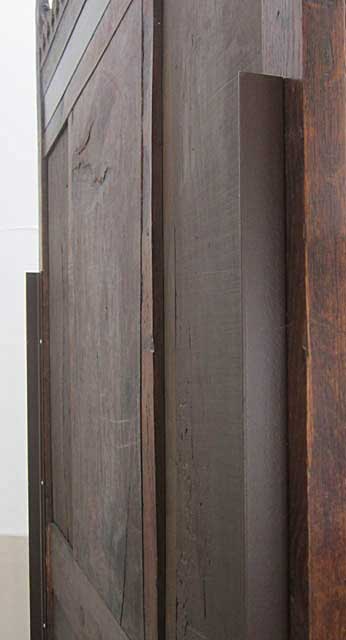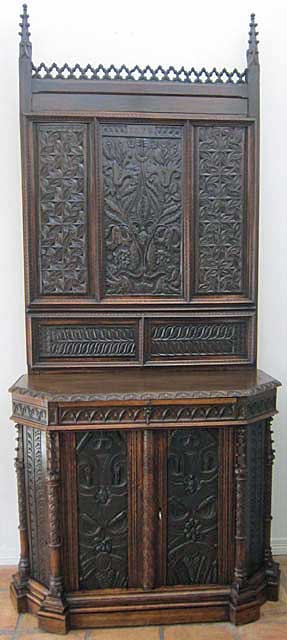
Every once in a while we find a piece that presents multiple mysteries of style and origin, and this is one of them. When we bought this piece in France, the seller described it as containing panels in a Renaissance Italian style from a high-backed chair (chayre) that had been "transformed" into a cabinet dating from around 1885.
Such transformations were not unusual in the 19th century as the attention of French consumers crystallized around furniture of the haute époque or what we would term Gothic and Renaissance styles. This passion was kindled by the efforts of Eugène Viollet-le-Duc to restore and protect medieval masterpieces of architecture such as Notre Dame de Paris and its effects were widespread. In addition to furniture, there was literature, (including The Hunchback of Notre Dame by avid Gothic furniture collector Victor Hugo), paintings (of knights and ladies in what was called the "Troubadour" style), and music (such as the opera Le Jongleur de Notre Dame by Jules Massenet).
Cabinet makers and dealers went to great and highly creative lengths to meet this demand. With a scarcity of (or prohibitive cost of) 19th century carvers skilled enough to make pieces look like those originating in earlier times, harvesting panels from furniture of centuries past, and placing them in more modern frameworks, became a common practice known as rajustage or a sort of "tidying up." As described in the book accompanying an exhibition at the Metropolitan Museum of Art in 2013,* a prominent Parisian furniture retailer, Maison Leys, routinely incorporated "Gothic" fragments and even arranged to ship some of them in 1847 to the royal Chateau at Pau for use in making contemporary furniture in the older styles for King Louis Philippe. This practice ensured the preservation of specific pieces for future generations of admirers but also stoked enthusiasm for the remarkable elements of design that they displayed.
In their attempts to satisfy this demand, furniture makers also studied pieces from earlier periods at museums such as the Louvre and the Cluny, and made faithful reproductions of them (including Chairs 5149 as well as Cabinet 5203 in our collection), now antiques in their own right. Craftsmen could also refer to books circulating widely among workshops, including engravings of designs from the Renaissance and from Viollet le Duc's publications.
For fascinating illustrations and discussions of this practice as part of an examination of furniture in the collection of the Louvre Museum see the recent book, listed below, by Agnès Bos. Whether scavenging, salvaging, refurbishing, rescuing, reconstituting, transforming, or re-imagining, it all went on at a time when documentation (such as a provenance) was scarce and so-called experts were also the dealers who offered these items for sale. As modern curators now acknowledge, quite a few 19th century mash-ups and outright fakes were fobbed off on obsessed, and oft-times gullible, collectors.
The following is a photograph from 1889 of a "Gothic Room" in Paris created by Emile Gavet, an elite collector/designer/dealer, who publicized his items with a printed catalogue written by a curator at the Louvre Museum, Emile Molinier. As was common at the time, their concept of "Gothic" included what we would consider items in the "Renaissance" style as well. Gavet inspired (and provided items for) the creation of the Gothic Room of Alva Vanderbilt in her Marble House in Newport, Rhode Island, many of whose contents ended up at the Ringling Museum in Sarasota, Florida. Not all can be reliably traced, whether in whole or in parts, to the haute époque (13th to 17th centuries).
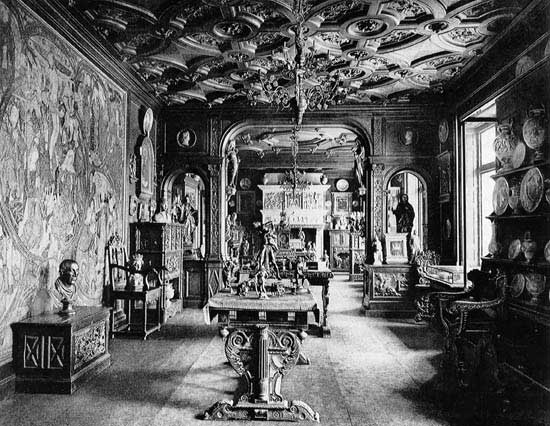
In light of all this, we will first consider the date, 1678, carved into the top of our cabinet in a cryptic script.
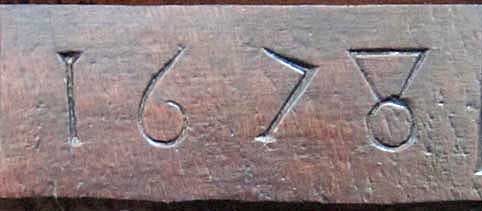
We have always been skeptical of pieces bearing dates since they are rarely encountered in Gothic and Renaissance style pieces. The choice of year may reflect an attempt in a later era to make a piece seem older than it is and justify charging a higher price. In this case, we cannot rule out completely the prospect that parts of this piece date back to the late 17th century, as the date indicates. However, verifying this date, as being associated with any elements of this cabinet, is not possible from the evidence at hand.
Whoever made our cabinet started with the lower part, in oak. It is six-sided (wide front panel, two narrower panels on each side, plus the back), and in that sense uses the typical "footprint" of a cabinet from the Renaissance era. The frieze with a drawer at the top is balanced by a wide moulding at the bottom, in between which extend tall Gothic style columns topped by spires. This mixing of Gothic and Renaissance elements is characteristic of this piece, and one of the delightful aspects of 19th century furniture evoking earlier times. In keeping with the mistaken belief in the 19th century that pieces from earlier times were very dark, the supposed Renaissance panels of this piece are darker than the oak of the 19th century cabinet framing them.
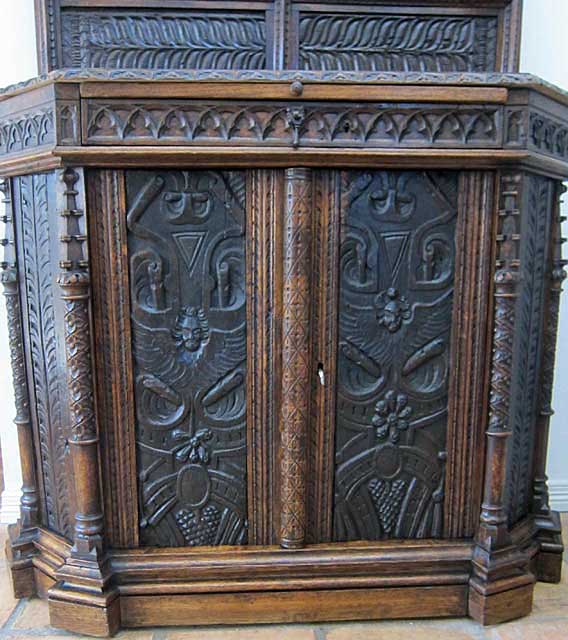
The base into which older (and darker) panels were incorporated is solid oak with a rich patina. It has a distinctly Breton flavor. We say that because it reminds us of the first cabinet we ever bought at the Marché aux Puces de Paris Saint-Ouen, the world's largest antique market. As newly-weds who had just relocated to Paris, we concluded that the faces on the outer doors of what the dealer termed a meuble breton must have been carved to celebrate a marriage long ago, although we could not discern which was the husband's and which was the wife's! We loved the Gothic elements, especially the tall spires on either side, and the Renaissance touches such as the scrolled strapwork near the top of the two outermost door panels. We learned that the swirling circular motifs on the drawer, the carved circular flowers on the top, and the ribbed geometric motifs on the door panels were all elements of Brittany's distinctive style.
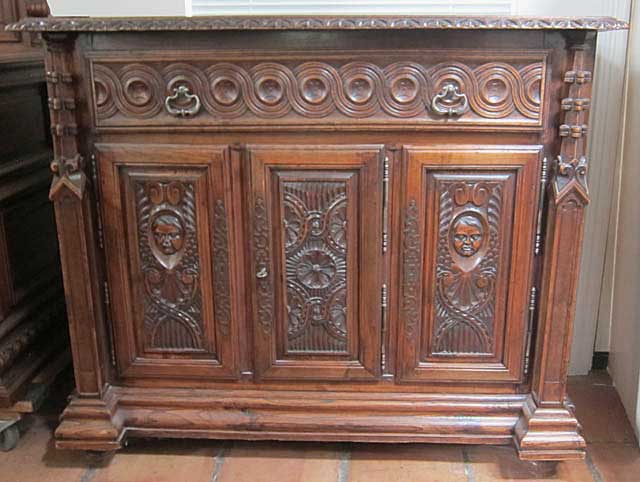
With the exception of that initial purchase, this cabinet 5223 and cabinet 3091 (sold some years ago), we rarely encounter pieces from Brittany with both Gothic and Renaissance elements. The 19th century art historian, Edmond Bonnaffé, in his book on 16th century French furniture published in 1887 (listed below), explains why. In a piquant essay on Brittany (made a part of France in 1532), he describes a place apart, whose inhabitants still stated they were "going to France" whenever they left their region. Renaissance style did not take hold there, despite the efforts of King François I (reigned 1515-1547) and his frequent visits to the area. The inhabitants of Brittany, with their own language and ancient culture, did not embrace newfangled design elements. Bonnaffé concluded that they cling obstinately to the circles and geometric shapes that characterized their "primitive traditions." It is just such elements, interspersed with those of the Renaissance, that we find all over this cabinet. For more about Brittany, and the War of the Breton Succession carved into wood, see Cabinet 3091.
The palm motif, found between the columns at the corners of the cabinet, is typical of Renaissance furniture but we have never seen it without a rounded tip. Here, the palm leaves just keep going, right to the top of the cabinet. This leads us to think that they may have come from another piece of furniture and were cut to fit into this one. The same characteristic is seen on the palm motifs on either side of each door panel. To see the palm motif as we would expect to see it, there is Chest 3213.
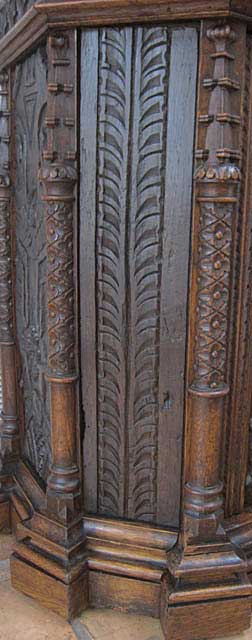
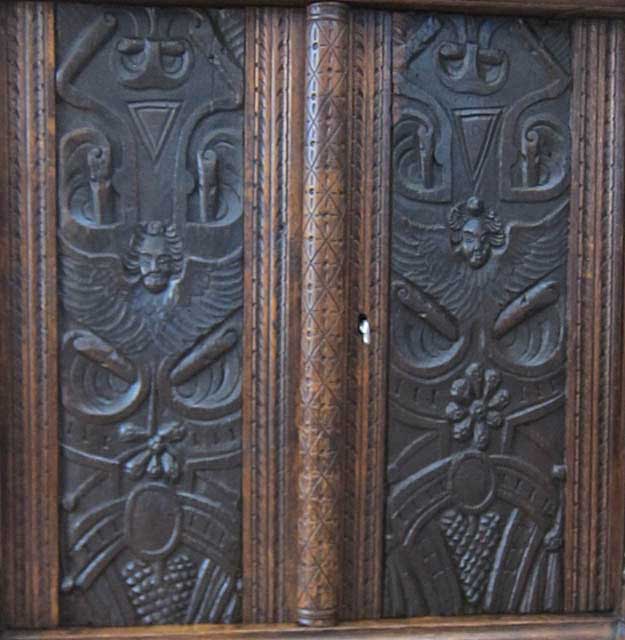
Most of the horizontal portion of the top of the cabinet has had to be replaced, by our master woodworker, owing to damage that appeared to be long-standing and involving the structural integrity of the piece. The new section of the top is of solid oak indistinguishable from the original and ready for several hundred more years of enjoyment.
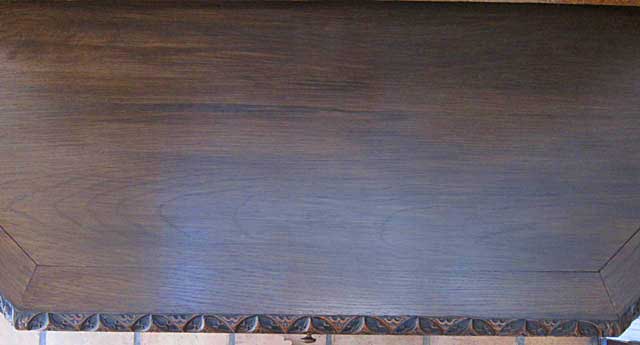
The replacement was accomplished in a way that did not affect the intricately carved border of Gothic tracery (elliptical forms known as mouchettes) alternating with halves of flowers, a motif also seen on our first meuble breton.
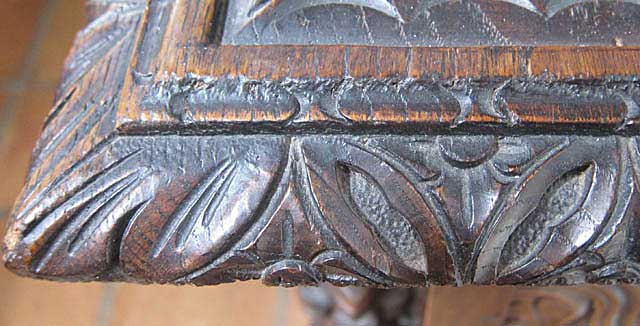
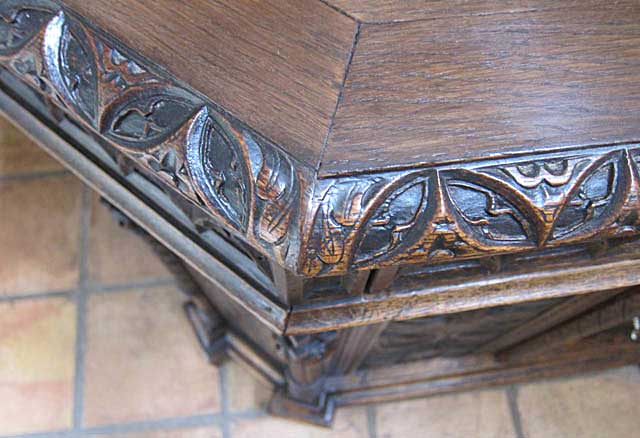
Just below this top, a carved frieze surrounds the piece. Emphatically Gothic, the repeating half-moon figures each contain two trefoils ornamented with cusps.

The front part of the frieze is made up almost entirely by a drawer. At both ends are lancet arches.

In the center is a drawer pull whose diagonal lines interspersed with small circles evoke the patterns on the columns of the cabinet.
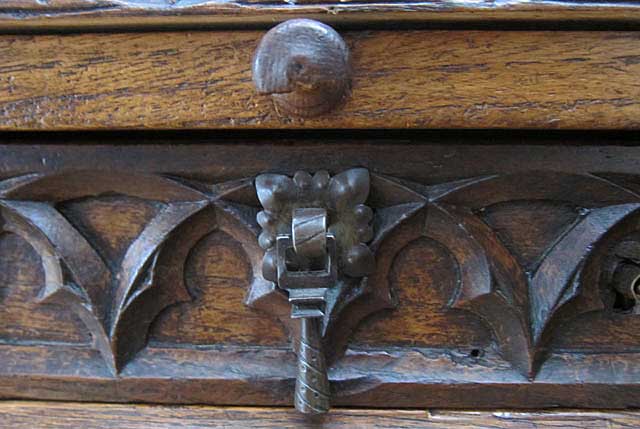
Above the center of the drawer is a knob used to pull out a horizontal surface for writing. We expect that some of the wooden support for sliding this piece have deteriorated and so the panel tends to tilt downward when extended.
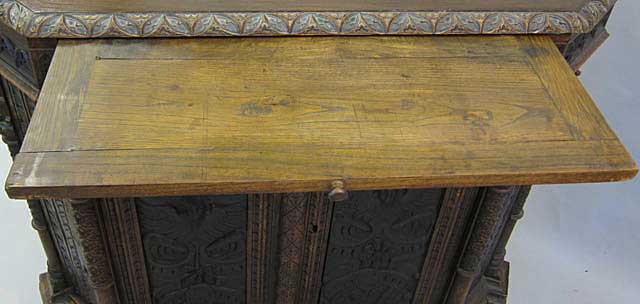
The base of the cabinet has four panels carved in low relief, darker in color than the elements framing them, and which may date from earlier times. They appear to have no relationship to the panels found on the tall upper section of the cabinet. Indeed, they seem to have no relationship to anything except to one another. Each has elements in common, such as an angelot or head of an angel with wings on either side, a triangle (sometimes with a circle in the center), curled shapes resembling strapwork, and a large blossom with droopy petals.
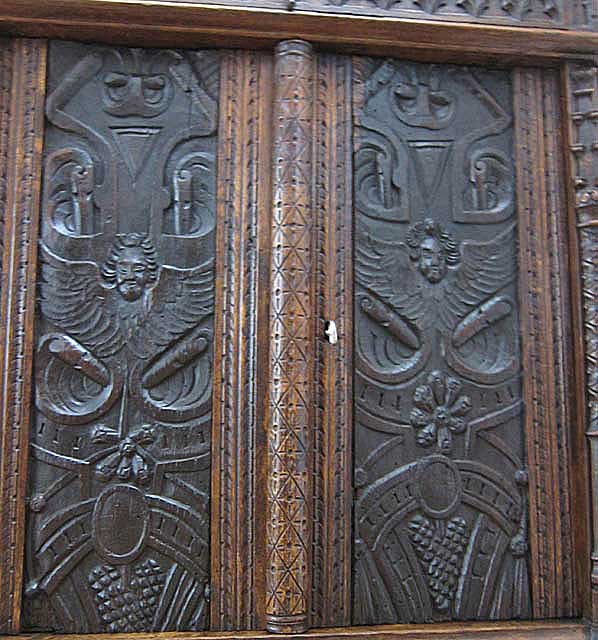
For example, the photo above shows the panels on the doors of the cabinet. The left panel has the angel and flower elements lower than on the right panel, leading us to conclude that each panel was cut from what was once a larger panel. The carving looks as if the design was copied from a book and the carver may have been having difficulties duplicating it. Moreover, the angel's head is not typical of Renaissance design in that it is not that of a child with short, tousled hair but rather an older looking figure with hair parted into sections on the sides and a sort of "man bun" on top. The eyes are slanted and not at all cherubic. The jowls are prominent and the brows furrowed.
Above the heads are inverted isosceles triangles with a circle in the center. The one on the left is smaller than the one on the right, which extends downward to meet the head of the angel. On either side of the triangles are curved shapes ending in curls, reminiscent of strapwork motifs (cuir découpé) in Renaissance decoration, especially in the designs of Rosso Fiorentino for the Gallery of François I at Fontainebleau. We can imagine Rosso cracking a smile over the attempts in these panels to evoke his consummate style.
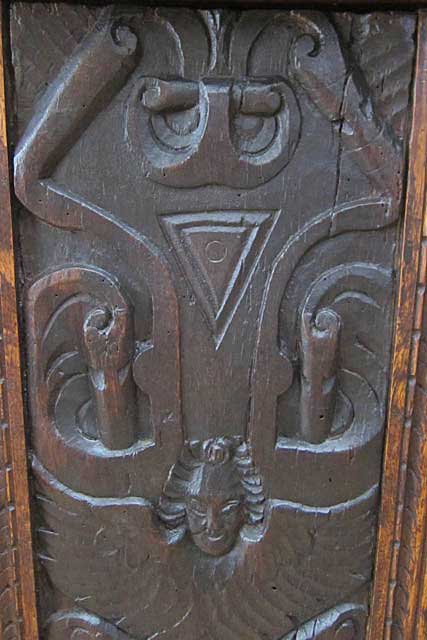
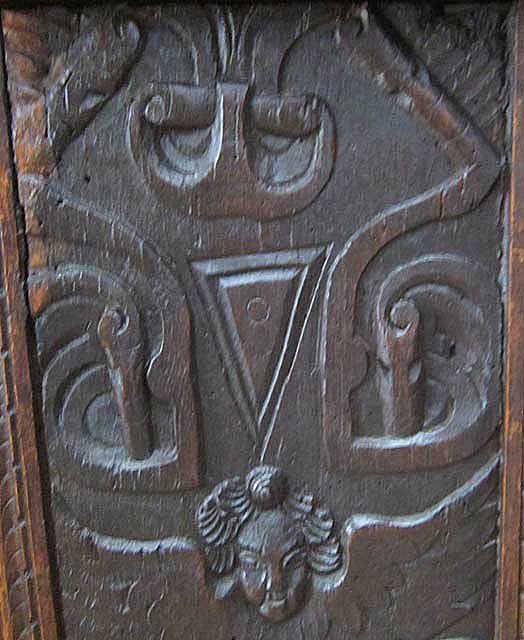
Similar designs were available in books of engravings that inspired generations of cabinet makers, as seen in this panel from a chest in the collection of the Hôtel-Dieu in Beaune. Dating from the second half of the 16th century, perhaps the came from just such a workshop of transplanted Italians in the Burgundy region.
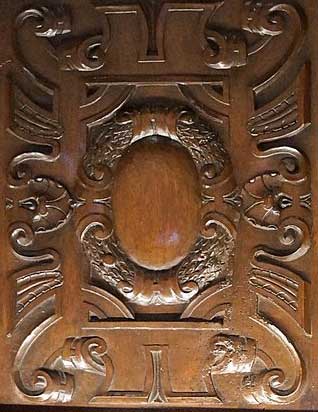
The lower parts of the door panels of our cabinet are also similar but not identical. The flower on the left has fewer petals (five) than the one on the right (seven). Both appear to be thrust into the frame with a stem intact and jutting off to the left. Below the flowers are oval figures, the one on the left being larger than the one on the right. Barely discernible is a cross in the center of each oval. Decorative bands curve away from the flowers and the ovals, ornamented with carved "I" shaped figures. Below the ovals are what appear to be stylized bunches of grapes with the similarity more evident on the right where the bunch is not cut off at a higher spot, as on the left. Above the flowers, and supporting the angels' wings, are the strapwork figures that appear to spiral out from concentric circles. Viewed from a distance, they resemble, eerily, the eyes of an owl.
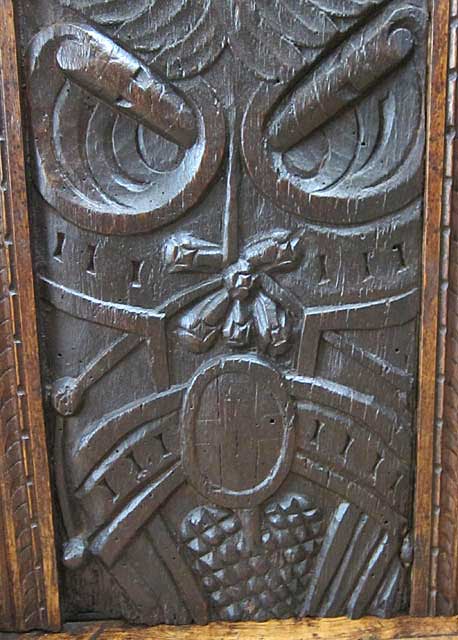
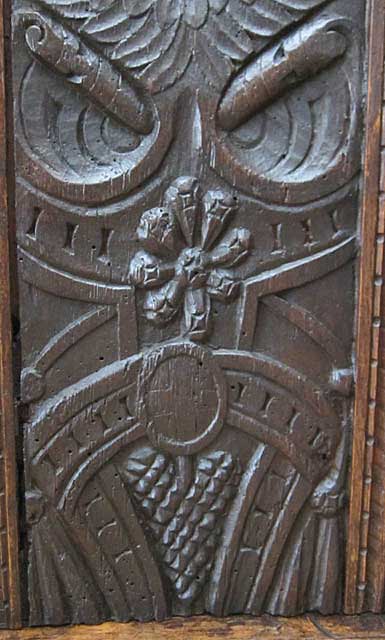
A similar panel is found on each side of the cabinet base. The following is from the left side of the cabinet.
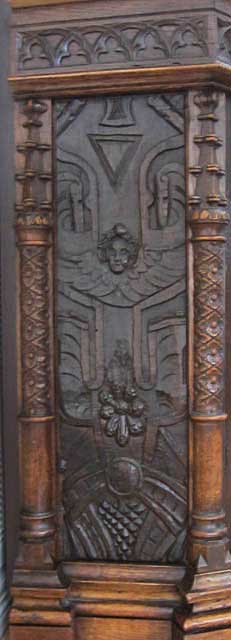
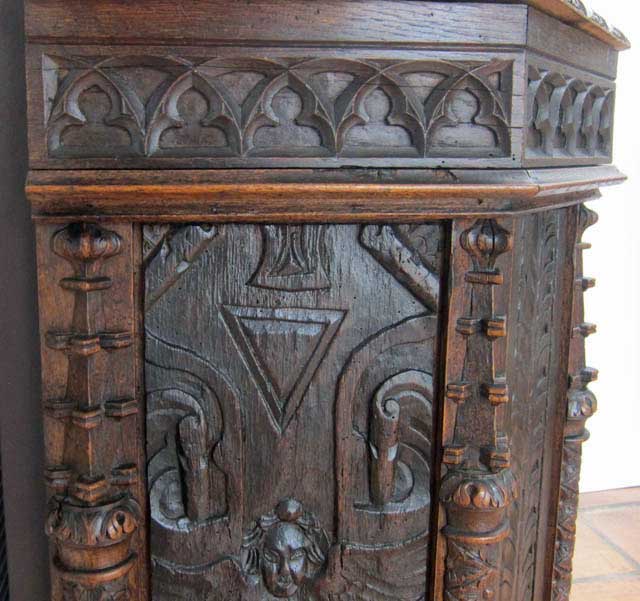
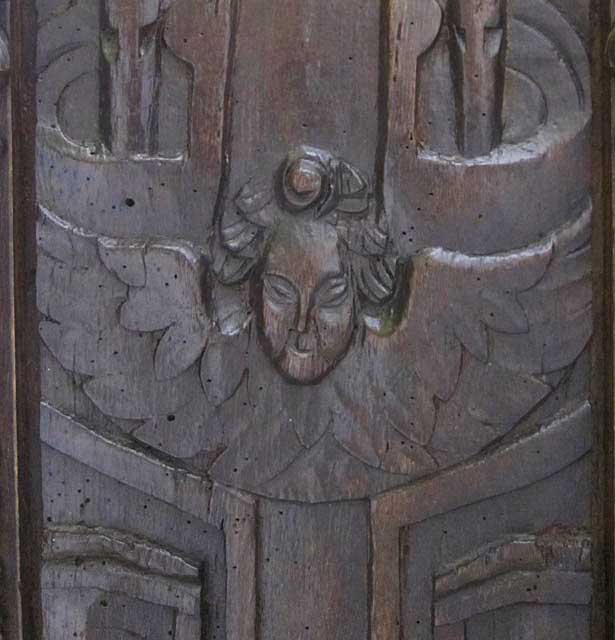
Our best guess as to the origin of the four similar panels on the base of the cabinet is that they may be from a rural church, probably in Brittany. With the carving approximate, and having religious symbolism, we expect that a local craftsman was doing his best at ornamentation based on Renaissance elements he had come to know along with the addition of typical Breton figures such as the triangles and circles as well as the flowers. That there are multiple, similar, panels suggests church furniture involving numerous panels such as a cabinet used for storing vestments and communion elements in a sacristy or choir stalls where priests would be sitting during services. Perhaps the panels were ripped out and cut apart in the aftermath of the French Revolution when anti-clerical sentiments ran high. Considering the sophisticated artistic energies and funds invested in elaborate carving of choir stalls and other furniture in French cathedrals during the Renaissance, we speculate that these panels were an attempt at imitation but in a less grand parish with a limited budget.
The carving on the piece above the cabinet is an entirely different matter. It is not original to the rest of the cabinet and incorporates no similar stylistic elements with the exception of the Gothic spires on either side of the top and the fenestrage or open tracery design of quatrefoils running between them. Just below this railing is an unadorned panel that replaces one missing when the cabinet was delivered to us.
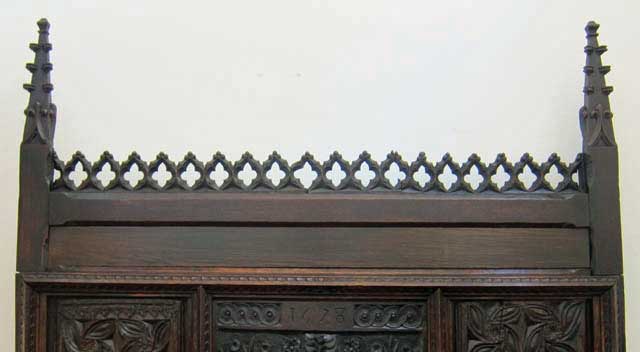
On the individual panels, the carving is very detailed and in low relief. The subject matter is secular in nature. A large central panel is based on an elaborate floral design with narrower panels on either side and two horizontal panels below.
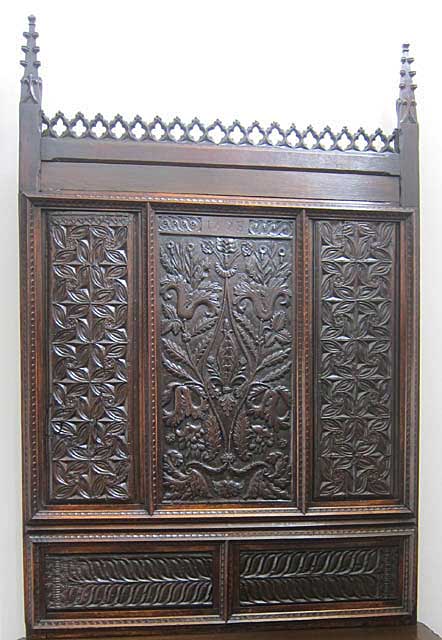
The central panel is likely what the seller was referring to when he mentioned that there were elements from a chayre or high-backed chair. The tall backs of such chairs had elaborate panels based on Renaissance design elements such as grotesque decoration involving vases and exuberant vegetal motifs. See, for example, Chair 5212. Most of the flowers appear to be tulips in various stages of opening, as seen in Dutch still life paintings from the 17th century such as those in the collection of the Ashmolean Museum in Oxford.
While the depiction of tulips might lead one to think that the panel came from somewhere in France closer to Holland, we should not forget that tulips were known all over Europe thanks to the tulip mania that captivated 17th century speculators, gardeners, and painters.
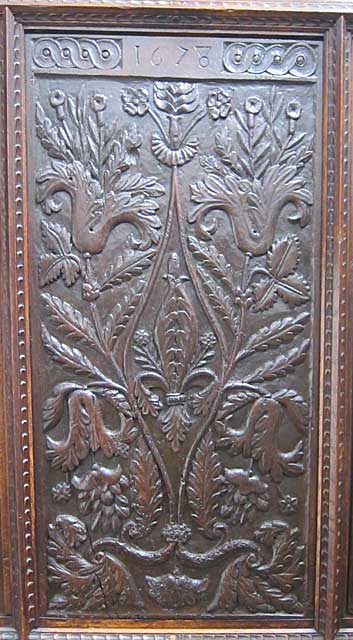
Commanding attention at the center of this panel is a tall fleur-de-lys. Typically connected with the royal lines of France, the one on this panel has stamens between the flower's lobes. This associates it with Italy, and specifically, Florence, as seen on Chair 4116. The lobes of the fleur-de-lys are carved to resemble leaves rather than petals. The central lobe has a leaf on either side and appears to end, at the top, with a bud. This is unlike any fleur-de-lys we have encountered.
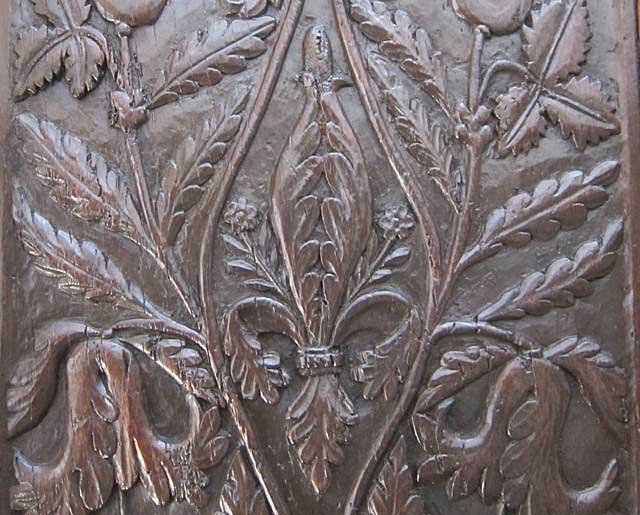
If the origin of the panel's style is Italian, this does not necessarily mean that someone from Italy made it there. During the Renaissance, many Italian craftsmen and artists (including Rosso Fiorentino) made their way across the Alps, especially after the Sack of Rome by Emperor Charles V in 1527. They established workshops in France where their inventive designs were disseminated throughout their adopted country.
Examining the carved elements comprising this central panel, what is striking is how lacking in symmetry they are. For example, seemingly matching blossoms and leaves touch at different points, depending on which side of the panel they are on. Flowers on one side have more petals than their "mirror images" on the other side just as leaves have differing numbers of indentations and curve at slightly different angles. We suspect that the carver was copying other works, perhaps engravings or prints, and may not have been highly experienced in sculpting solid oak. The overall effect, however, is attractive and pleasing to the eye.
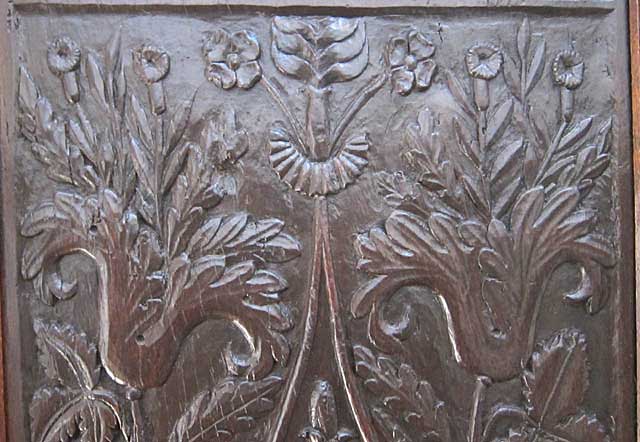
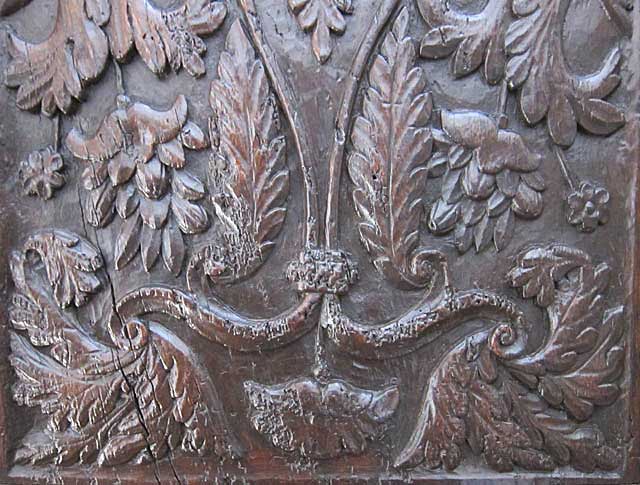
This central panel has no elements that are identifiable as Breton, except for the ornamentation on either side of the date at the top of the panel. The interlocking circular patterns on either side of the date are characteristic of furniture from Brittany. The date itself, a triangle atop a circle for the number eight, may be a distillation of the geometric figures so popular in Breton design and of the shapes found over the heads of the angels in the panels of the cabinet's base.
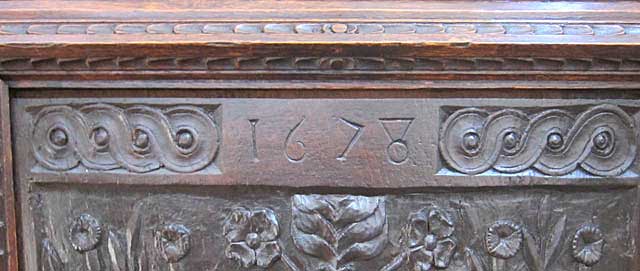
It is when we examine the panels on either side of the central panel that the upper portion of this cabinet takes on a more distinctly Breton flavor. As with the panels on the base of the cabinet, these two are not identical. The one on the left has an additional border at the top.
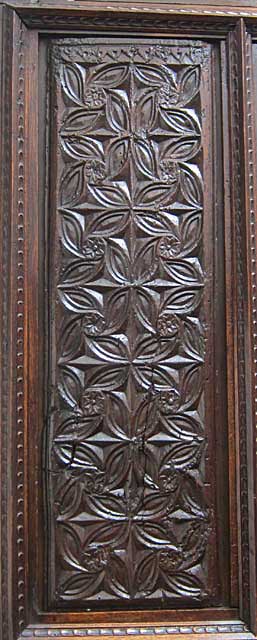
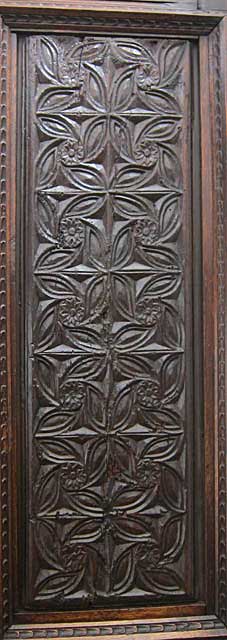
The repeating rectangular sections comprising the panels each contain two four-lobed figures, with a flower at the center, which appear to spiral leftward like a pinwheel. Similar motifs are offered by Bonnaffé as characteristic of the region of Brittany and are seen on two door panels of Cabinet 5185.
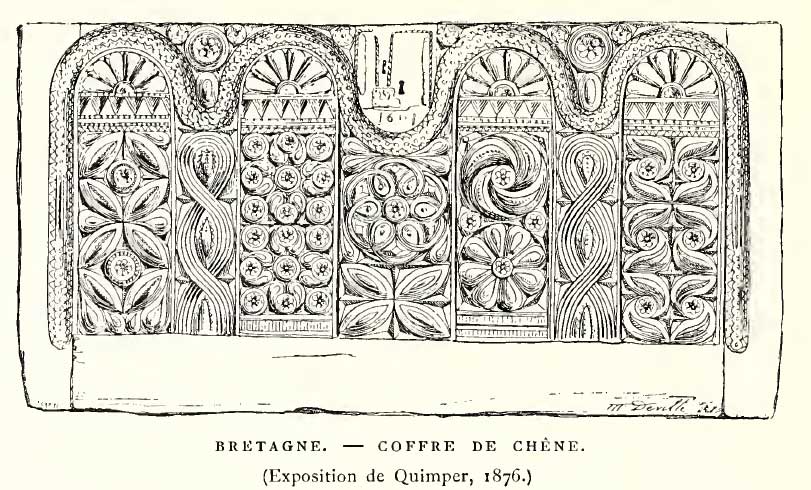
Examining the rear side of the upper part of the cabinet, it is evident that the central panel is thicker than the two side panels. We have no reason to believe that the central panel is from the same source as the ones on either side of it.
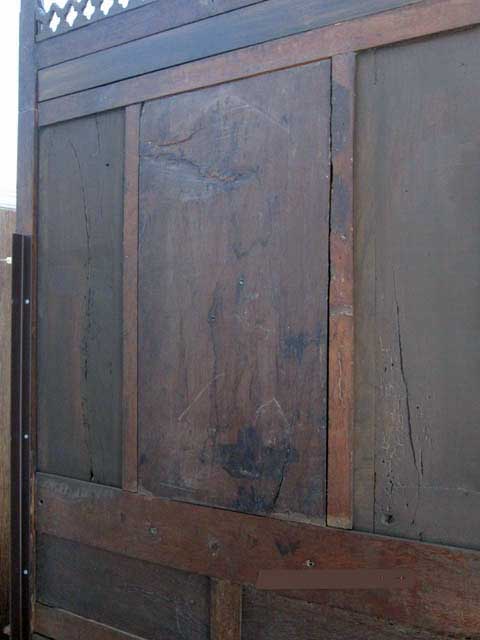
At the lowest level of the upper part of this cabinet are two matching rectangular panels. While reminiscent of palm motifs, they are wider and the fronds are more curved.

At the very top of the piece, the spires mirror those on the lower part of the cabinet in overall shape and crocketing.
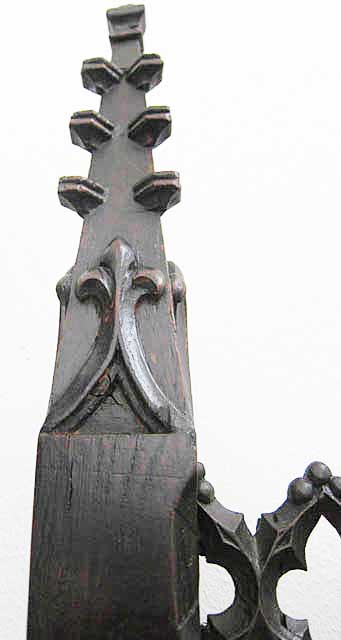
Just below them are ermine tails, announcing emphatically the Breton heritage of this piece — or at least parts of it. The symbol was associated with Brittany and appeared on its coat-of-arms while the region was still an independent duchy. The ermine tail is incorporated into the region's flag, waved proudly by Bretons each year along roads all over France during the Tour de France.
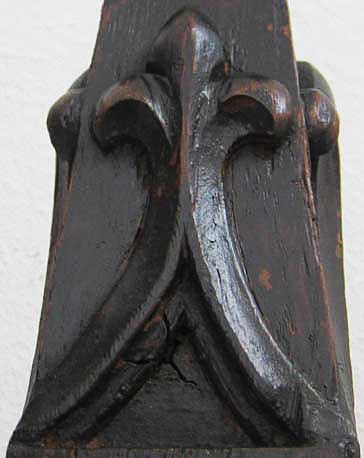
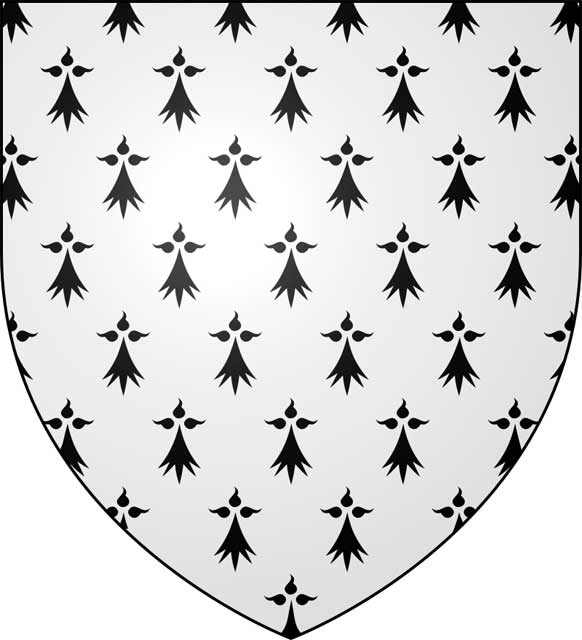
The cabinet doors lock with a key, which we have. While there is a keyhole on front face of the drawer, the key has not made its way to us although the drawer opens without it. The interior of the cabinet was finished with red felt and we have not altered it.
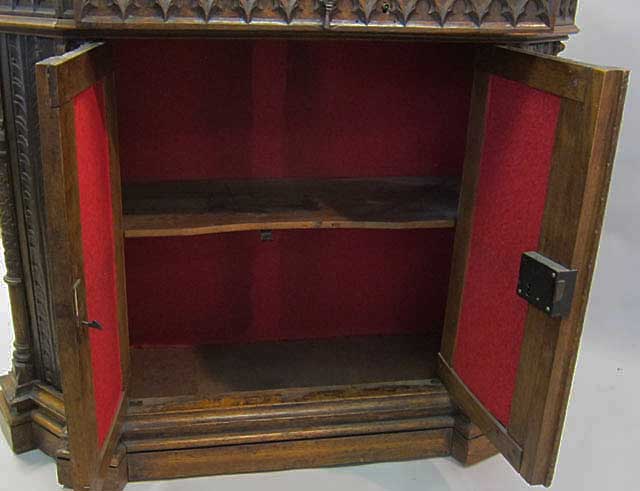
To prevent future warping of the heavy back piece and to keep it from leaning forward, the top part has been screwed to the base with long pieces of steel, painted brown. The cabinet can be disassembled for purposes of transport and delivery.
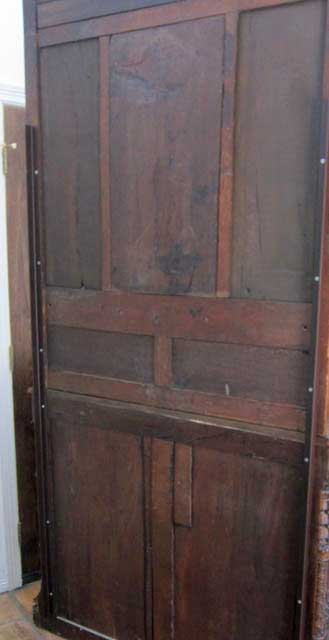
Additional photos are below.
Reference
Bonnaffé, Edmond, Le Meuble en France au XVI Siècle (Librairie de l'Art, Paris, 1887); Bos, Agnès, Mobilier du Moyen Age et de la Renaissance — La Collection du Musée du Louvre (Editions du Musée du Louvre/Somogy, Paris, 2019); Bos, Agnès, Decorative Arts/Furniture in Gothic Art in the Gilded Age (see, Brilliant, below); Brilliant, Virginia, Gothic Art in the Gilded Age — Medieval and Renaissance Treasures in the Gavet-Vanderbilt-Ringling Collection (Ringling Museum of Art, Sarasota, 2009); Charles, Corinne, Visions d'Intérieurs, du Meuble au Décor (Paris-Musées, Paris, 2003); *Kisluk-Grosheide, Danielle, et al, Salvaging the Past: Georges Hoentschel and French Decorative Arts from The Metropolitan Museum of Art (Metropolitan Museum of Art, New York, 2013); Piat, Florence, Les stalles de l’ancien Duché de Bretagne, (L'Université Européene de Bretagne, Rennes, 2012); Robb, Graham, The Discovery of France — A Historical Geography, W.W. Norton (New York, 2008); Thirion, Jacques, Le Mobilier du Moyen Age et de la Renaissance en France (Editions Faton, Dijon, 1998); Viollet-le-Duc, Eugène, Le Mobilier Médiéval (Georges Bernage, editor) (Editions Heimdal, 2003)
Uses
Without a doubt, this piece is one of the quirkier ones we have offered, owing to the mixture of panels and how they have been adapted to fit a 19th century framework. These characteristics bestow on the cabinet a charm all their own. As such, this cabinet should be a focus of attention in any room and a commanding presence owing to its height and its Gothic spires.
